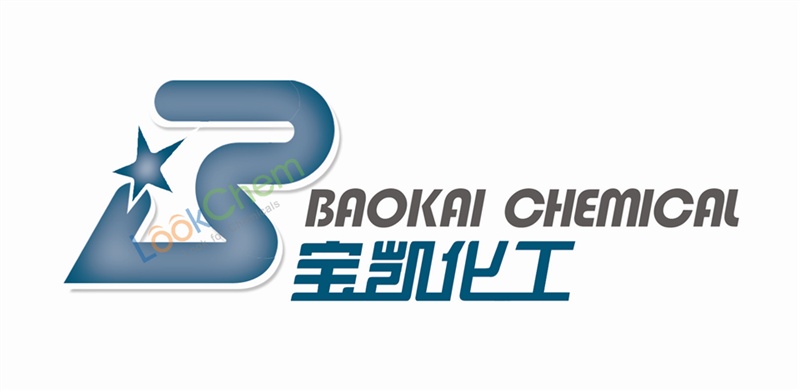chlorodifluoroacetic anhydride msds
- Product Details
- Company Profile
Chlorodifluoroacetic anhydride (CAS No. 2834-23-3) msds detailed information are provided by the Nantong Baokai Chemical Co., Ltd. This company is a specialized technical researching, developing and manufacturing enterprise.
1. IDENTIFICATION OF THE SUBSTANCE/MIXTURE AND OF THE COMPANY/UNDERTAKING
Product name: Chlorodifluoroacetic anhydride
2. HAZARDS IDENTIFICATION
Classification of the substance or mixture
According to Regulation (EC) No1272/2008
Acute toxicity, Dermal (Category 4)
Acute toxicity, Oral (Category 3)
Skin corrosion (Category 1B)
According to European Directive 67/548/EEC as amended.
Harmful in contact with skin and if swallowed. Causes burns.
3. COMPOSITION/INFORMATION ON INGREDIENTS
Formula: C4Cl2F4O3
Molecular Weight: 242,94 g/mol
CAS-No.: 2834-23-3
EC-No.: 220-603-4
4. FIRST AID MEASURES
General advice
Consult a physician. Show this safety data sheet to the doctor in attendance.
If inhaled
If breathed in, move person into fresh air. If not breathing give artificial respiration Consult a physician.
In case of skin contact
Take off contaminated clothing and shoes immediately. Wash off with soap and plenty of water. Consult a physician.
In case of eye contact
Rinse thoroughly with plenty of water for at least 15 minutes and consult a physician.
If swallowed
Do NOT induce vomiting. Never give anything by mouth to an unconscious person. Rinse mouth with water. Consult a physician.
5. FIRE-FIGHTING MEASURES
Suitable extinguishing media
Use water spray, alcohol-resistant foam, dry chemical or carbon dioxide.
Special protective equipment for fire-fighters
Wear self contained breathing apparatus for fire fighting if necessary.
6. ACCIDENTAL RELEASE MEASURES
Personal precautions
Use personal protective equipment. Avoid breathing vapors, mist or gas. Ensure adequate ventilation. Evacuate personnel to safe areas.
Environmental precautions
Do not let product enter drains.
Methods and materials for containment and cleaning up
Soak up with inert absorbent material and dispose of as hazardous waste. Keep in suitable, closed containers for disposal.
7. HANDLING AND STORAGE
Precautions for safe handling
Avoid contact with skin and eyes. Avoid inhalation of vapour or mist.
Normal measures for preventive fire protection.
Conditions for safe storage
Store in cool place. Keep container tightly closed in a dry and well-ventilated place. Containers which are
opened must be carefully resealed and kept upright to prevent leakage.
8. EXPOSURE CONTROLS/PERSONAL PROTECTION
Personal protective equipment
Respiratory protection
Where risk assessment shows air-purifying respirators are appropriate use a full-face respirator with multi-purpose combination (US) or type ABEK (EN 14387) respirator cartridges as a backup to engineering controls. If the respirator is the sole means of protection, use a full-face supplied air respirator. Use respirators and components tested and approved under appropriate government standards such as NIOSH (US) or CEN (EU).
Hand protection
The selected protective gloves have to satisfy the specifications of EU Directive 89/686/EEC and the standard EN 374 derived from it. Handle with gloves.
Eye protection
Tightly fitting safety goggles. Faceshield (8-inch minimum).
Skin and body protection
Choose body protection according to the amount and concentration of the dangerous substance at the work place.
Hygiene measures
Handle in accordance with good industrial hygiene and safety practice. Wash hands before breaks and at the end of workday.
9. PHYSICAL AND CHEMICAL PROPERTIES
Appearance: liquid
Colour: colourless
10. STABILITY AND REACTIVITY
Chemical stability
Stable under recommended storage conditions.
Conditions to avoid
no data available
Materials to avoid
Strong oxidizing agentsStrong oxidizing agents, Strong bases
Hazardous decomposition products
Hazardous decomposition products formed under fire conditions. - Carbon oxides, Hydrogen chloride gas, Hydrogen fluoride
11. TOXICOLOGICAL INFORMATION
Acute toxicity
no data available
Skin corrosion/irritation
no data available
Serious eye damage/eye irritation
no data available
Respiratory or skin sensitization
no data available
Germ cell mutagenicity
no data available
Carcinogenicity
IARC: No component of this product present at levels greater than or equal to 0.1% is identified as probable, possible or confirmed human carcinogen by IARC.
Potential health effects
Inhalation: May be harmful if inhaled. Material is extremely destructive to the tissue of the mucous membranes and upper respiratory tract.
Ingestion: Harmful if swallowed. Causes burns.
Skin: Harmful if absorbed through skin. Causes skin burns.
Eyes: Causes eye burns.
Signs and Symptoms of Exposure
Material is extremely destructive to tissue of the mucous membranes and upper respiratory tract, eyes, and skin., spasm, inflammation and edema of the larynx, spasm, inflammation and edema of the bronchi, pneumonitis, pulmonary edema, burning sensation, Cough, wheezing, laryngitis, Shortness of breath,
Headache, Nausea
12. ECOLOGICAL INFORMATION
Toxicity
no data available
Persistence and degradability
no data available
Bioaccumulative potential
no data available
Mobility in soil
no data available
PBT and vPvB assessment
no data available
Other adverse effects
no data available
13. DISPOSAL CONSIDERATIONS
Product
Observe all federal, state, and local environmental regulations. Contact a licensed professional waste disposal service to dispose of this material. Dissolve or mix the material with a combustible solvent and burn in a chemical incinerator equipped with an afterburner and scrubber.
Contaminated packaging
Dispose of as unused product.
14. TRANSPORT INFORMATION
ADR/RID
UN-Number: 3265 Class: 8
Packing group: II
Proper shipping name: CORROSIVE LIQUID, ACIDIC, ORGANIC, N.O.S. (Chlorodifluoroacetic anhydride)
IMDG
UN-Number: 3265 Class: 8
Packing group: II EMS-No: F-A, S-B
Proper shipping name: CORROSIVE LIQUID, ACIDIC, ORGANIC, N.O.S. (Chlorodifluoroacetic anhydride)
Marine pollutant: No
IATA
UN-Number: 3265 Class: 8
Packing group: II
Proper shipping name: Corrosive liquid, acidic, organic, n.o.s. (Chlorodifluoroacetic anhydride)
15. REGULATORY INFORMATION
This safety datasheet complies with the requirements of Regulation (EC) No. 1907/2006
Verified Supplier
Nantong Baokai Chemical Co., Ltd (Hangzhou Baokai Bio-Chemicals Co.,Ltd.)
- Country:
 China (Mainland)
China (Mainland) - Year Established: 2003
- Business License:

- Business type: Trading Company
- Integral:


Contact Details|Similar Products

Escrow ServiceMore
Secure Your Orders With escrow More Transparency,Less Uncertainty


 Add to inquiry cart
Add to inquiry cart


